|
Following a wave of posts on the Pentrace Message Board
concerning Nakaya pens, Pentracers Fran DeRespinis and Adam Frank spoke to
Len
Provisor about their recent acquisitions. Nakaya nib photo by Fran DeRespinis

Len: Why did you decide to purchase a Nakaya fountain
pen?
Adam: I had seen a number of
posts about these wonderful pens that were hand-crafted, wrote perfectly, were
custom-made for the user and were quite nice-looking. I had longingly looked at
many maki-e pens that I couldn’t afford, and I saw the Nakaya urushi pens
as the base for most maki-e and a good starting point. I re-read Russ
Stutler’s article, visited Nakaya’s
Web site, and made my decision—my next pen was going to be a Nakaya.
I mean, how many pens are made “For Your Hand Only”?
Fran: My experience was similar to Adam’s. Interestingly though, it
was Adam’s post on Pentrace that pushed me over the edge, so to speak. That
is, he was so high on his new Nakaya that I decided to take the plunge. It was
like that one last positive film review that sends you to the theater.
Len: What other Japanese pens are in your collection, or
is this your first?
Fran: I have only owned a few modern Namiki. The ones I currently have are
an Impressions and a second-generation (modern) Vanishing Point, both of which
I consider to be top-notch pens both in terms of quality and writing performance.
Adam: I have a few modern Namiki (Bamboo, Nippon Art Phoenix, Carbonesque
and Mandarin Vanishing Points) and a few vintage Pilots (Murex, Super, one or
two others that I got from Ron Dutcher’s eBay auctions before everyone realized
what terrific pens he has available). I also have a Sailor 1911 with a “Binderized”
crisp italic nib. All of my Japanese pens are wonderful writers, very reliable
and extremely well-made—and those are just the machine-made pens.
Len: What role did Pentrace play in your making this purchase?
Adam: Nakaya came to my attention because of publicity on Pentrace—all
of a sudden, there was at least a thread or two a day about Nakaya. I decided
to look into these pens, and that was that. But it had nothing to do with Nakaya
being the “pen of the moment”—as soon as I visited their web
site, it was inevitable that I’d get one.
Fran: Yup, me too. All the chatter on Pentrace was good information. Seeing
the Nakaya Web site and hearing all the good reports moved me to consider a Nakaya.
Len: Which model did you purchase? Why?
Fran: I decided on the Urushi Wajima-nuri -Tamenuri in red. Of course, if
you haven’t seen it on their Web site you would think it’s the color
red. Instead, it’s a deep, deep near-black brown with red lacquer highlights
peeking through. It struck me as gorgeously subtle. Admittedly, I first wanted
one of those in-yer-face orangy red ones, but I decided to go for my version of
sophistication instead. I have no regrets. Oh, and there was no doubt that I wanted
an urushi lacquer model. That was the original appeal of a Nakaya for me.
Adam: I also have the red Tamenuri.
While looking over the Nakaya site, I decided that I wanted a pen that was uniquely
Japanese. And if my pen was going to be handmade, I wanted it to be noticeably
handmade—the celluloid, leather, demonstrator and even the plain ebonite
pens were out of consideration because they *could*
have been machine-made. So that really narrowed it down to the urushi, which I
thought was spectacular anyway. Like Fran, the lacquer was part of the original
appeal of a Nakaya. And after seeing the bowl
that demonstrates the changes the urushi goes through over time, my decision was
made. In fact, I thought of getting the blue or green tamenuri, but I was afraid
they would be too dark and wouldn’t show the undercoating well enough.
My experience with the color is exactly the same as Fran’s. The red
peeks out at the edges and ends, and I look forward to the color and color balance
changing over time.
Len: Given the great variety and options with Nakaya products,
what characteristics were you looking for in selecting the model you chose?
Adam: I wanted something unique that I couldn’t get from any other manufacturer
at a similar price. The celluloid patterns are similar to those from Platinum
and others. The wood and leather didn’t attract me. The ebonite are nice,
but didn’t grab me. I like demonstrators, but not when the filling mechanism
is a cartridge/converter—what’s the point? Mostly, I wanted something
I liked. And the urushi was what had attracted me to Nakaya in the first place.
Fran: Again, Adam and I are on the same page here. Though so many other of
the Nakayas I saw on their Web site are appealing, it was obvious that it was
an urushi that really caught my eye. Interestingly, I first ordered the more modest
ebonite Writer’s Pen model. As soon as I placed the order I regretted it,
realizing I really wanted the urushi tamenuri. I immediately sent an e-mail to
Nakata san and changed the order.
Len: The Wajima-nuri Tamenuri-red seems to have an almost
mystic appeal. Nakaya describes this "Tame" means "pool" and
"nuri" refers to the lacquer coating process. You can actually see through
the layers of clear urushi lacquer as if you were looking into a pool.
Does this accurately describe what you see with this pen in your hand?
Adam: Yes, but the description really doesn't do justice to the beauty of
the pen.
Fran: It’s a great description
and I agree with Adam. The pen is far more beautiful in the hand. My photos don’t
come close to showing the red highlights as they actually are. We need a better
photographer here!
Len: Did you order the plain gold or the two-tone gold nib?
Adam: Plain. I thought it went better with the pared-down simplicity of the
pen itself.
Fran: Same here. And no regrets

Nakaya plain gold nib
Photograph Copyright Fran DeRespinis 2003
Len: What was the buying process like? Was the order form
easy to complete?
Fran: It was easy. I just stepped myself through the different pages, selecting
what I wanted on each, and was finished within a few minutes. I did pay with a
credit card, which I think makes the process a lot easier. And when I changed
my order, Nakata san replied to my e-mail for confirmation of my change. He was
good, real good.
Adam: My experience was similar to Fran’s—I answered the questions
on the form, entered my credit card information, and was done within five minutes.
Len: Did any pen manufacturer or dealer ever ask you before
about your writing pressure, angle of pen or nib in hand?
Adam: Once or twice, particularly when I was starting out buying fountain
pens, dealers (notably Joon and Fountain Pen Hospital) asked about my writing
pressure. I ended up with Auroras initially. ;-) And of course restorers like
Richard Binder and Hal Arnold ask similar questions in order to get balance, nib
angle, etc. just so. But no, in the ordinary course of things no manufacturer
or dealer asks.
Fran: The only similar experience I had was back in 1996. A local pen store
in Raleigh used to have pen reps show up to display their wares. A fellow named
Scott Love was a rep for Lamy and Aurora at the time and he asked me about my
writing style and preferences to help me buy a pen. I wound up with my first Lamy
2000.
Len: How prompt was the correspondence once you placed
your order?
Fran: It was amazing. Given the thirteen hours difference, I received the
first e-mail back for Nakata san the very next day. Actually, he responded within
hours of receiving my e-mail, but I saw it the next morning when I logged on to
my e-mail. I was impressed.
Adam: I didn’t hear anything for about 5 days (including a weekend).
I emailed Nakata san with all my information again; he emailed back his original
response (sent the day after I placed my order), which had gotten lost in cyberspace,
along with an apology for causing me distress. He was *wonderful* to deal with.
Len: When you received the pen, what were your initial
reactions?
Adam: Well, I’ve written about this on the message board and a couple
of the pen lists. It was an epiphany for me—receiving this pen was everything
that I wish every pen experience was. It was anticipation; it was expectations
being met and exceeded; it was joy and wonder at the attention to detail; it was
a thrill of knowing that the pen was made just for me.
I thought that the packaging was beautiful, quite in keeping with the spirit
of the pen. And I had a lot of fun opening the outer box; opening the inner box;
taking the pen out of the pouch and finally uncapping the pen.
The outer (paper) box was made from the same paper as my Certificate from
Nakata san and the other artisans who made my pen. That’s a detail that
I noticed after a while and that impressed me deeply. In comparison, my Sailor
Black Meteor—a more expensive pen with similar packaging (wood, pouch, etc.)—came
in a plain white cardboard outer box. That just shows the level of detail attended
to by the Nakaya artists.
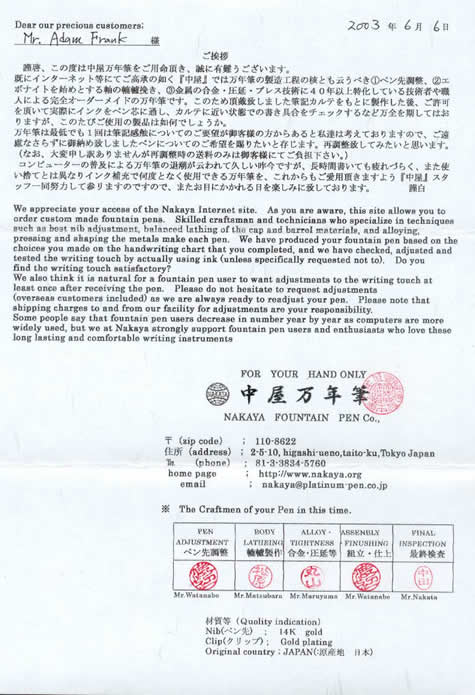
Certificate from Nakata-san
Fran: Yeah, you should just include Adam’s gushing post after he got
his pen. Ha! Let me add just a couple of other things here. I’ve bought
Limited Editions where the packaging is outrageous. I’m thinking about an
OMAS Extra Lucens LE, for example. The packaging was a huge Lucite box that was
definitely a hit to the price of the pen. Actually, it was a put-off to me because
it distracted me from the pen. And I mean in a negative way. It was just too much,
just as some other pen packaging is. Frankly, the simplicity of the Nakaya packaging
was perfect. It’s subtle, it’s practical, and it’s elegant.
The effort and cost was put into the pen and not the box, yet the box is wonderful
as it is. And the cloth pen case is a real match for the pen. I love it.
As for my initial reaction to the pen, it was all in the feel of it in my
hands. I was so glad I didn’t get a clip or trim. I loved the smooth, continuous
flow of the urushi lacquer. When I uncapped the pen, I was equally impressed with
how it fit and felt in my hand. It was just perfect and I breather a sigh of relief.
Len: Now that you have it, what do you like about your
Nakaya?
Fran: First and foremost, I like how the pen feels in my hand. That is unposted,
of course. It’s a monster posted and it’s not recommended you post
it anyway. But, unposted, this is one of the most comfortable pens I own. Now,
I like big pens, but I like the girth of the section to be moderate. My idea of
comfortable is a Conway Stewart Churchill, a Montegrappa Extra, a MB 146, or this
Nakaya. And the Nakaya is light weight, balanced beautifully and just sweet in
the hand. After that it has to be the luxurious feel of the urushi lacquer. So,
it’s a bit of Eros that appeals to me first and foremost, despite the fact
that this baby is also a wonderful writing instrument.
Adam: I like the way it writes, the way it looks and the feel of the urushi.
“Tame” means “pool”, and looking into the lacquer
really is like looking into a deep, liquid, beautiful pool. People extol the virtues
of celluloid—its warmth in the hand in particular. I frankly can’t
tell the difference between acrylic and celluloid generally (my Montegrappa Symphony
and Harmony felt similar to my hand), but boy can I tell when I’m holding
this lacquer pen! It’s unique among pen materials with which I’ve
had experience. As Fran says, it’s luxurious.
And as I buy pens to write with, I *really* like
the way it writes. The pen is huge, but light and extremely well-balanced. It’s
comfortable whether I’m holding it normally or for a more calligraphic effect.
The stub is extremely fine, but there is discernable, albeit subtle, line variation,
which I find very impressive given the size of the nib tip.
Len: What is your writing experience like with your Nakaya?
Adam: I can write with it normally
and not engage the flex, as I have a light touch normally and the nib is semi-flex
at best. But as you can see from the writing sample, this baby can perform!
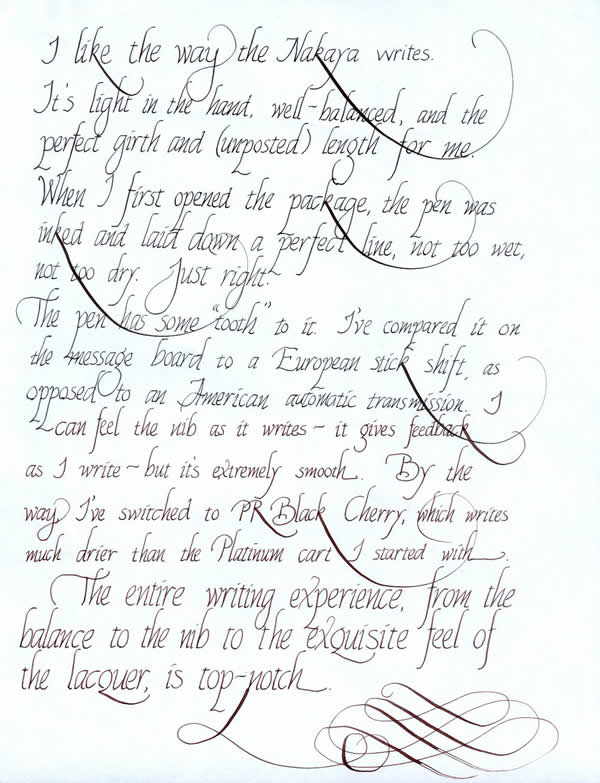
Adam's writing sample with the Nakaya
Fran: Okay, it’s been
a love fest thus far but I have to admit something here. I’m not all that
much of a fan of flexible nibs. I’ve owned some truly flexible vintage pens
and sold them all. It’s just not for me. So, though this soft fine nib is
awesome to write with, I now realize that I prefer not to flex and so this Nakaya
is being used more as an extra fine writer rather than one with expressive variation.
Of course, no matter how I write with it, I do manage to get variation. It’s
really quite nice.
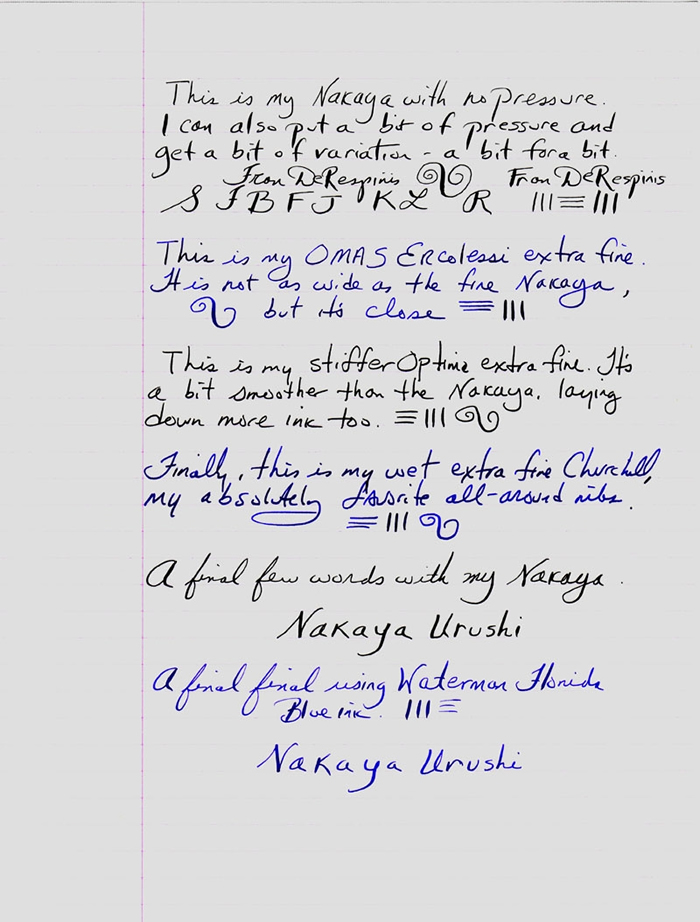
Fran's writing sample with the Nakaya
Len: Have you noticed a difference in performance using various inks?
Adam: I've used Platinum black, which was wonderful, and now PR Black Cherry,
which gives a drier line and has a tendency to skip on startup. It also sometimes
doesn’t allow for full flex. See the writing sample – the last two
swashes at the bottom show this effect (split tines with no ink between then).
I'm thinking of going back to Platinum ink, or giving the European cart adapter
a try.
Fran: Interestingly, I found my favorite black, Aurora, to be a bit dry. Waterman
black and Waterman Florida Blue are writing quite nicely. I haven’t tried
others yet.
Len: If you are using different inks, how does more or less
ink flow change the nib performance?
Fran: I really don’t have much experience with this yet, though I will
say that when I press hard (which I don’t really like to do much), the Aurora
line was fuller.
Adam: With a total sample of 2 inks, the Platinum far outperformed the PR
Black Cherry.
Len: Did you have good ink flow at first touch, or did
you have to flush and lubricate the ink channels with soap/water solution?
Adam: The pen wrote beautifully from the first moment it touched the paper.
No flushing of the converter or feed was necessary. I liked the fact that it was
inked when I received it as well.
Fran: Same here. I flushed with water when I first handled the pen and then
filled it up. Wrote perfectly and still is doing so. First time, every time.
Len: Is there anything that you don’t like or would
change if you could?
Fran: Well, I have to admit that as much as I really like the fine nib, a
medium would be more practical for me. I purposely bought the “soft fine”
to dedicate the pen to journaling, but I like writing with it so much that I could
use it more if it had a medium width nib. I thought about returning it for an
exchange, but each time I use it, I realize it’s okay just as it is. I’m
still wavering about an exchange, though.
Adam: Well, if I could I would
change it into one of Nakaya’s maki-e pens . . . . Seriously, there is nothing
about this pen I would change. I might not make the same choices for my next Nakaya
(like Fran, I want to try a wider nib), but I wouldn’t change mine one iota.
Len: How do you feel about the pen being a c/c filler?
Adam: I like it. I don’t particularly care for eyedroppers; I find them
messy to fill and write with, they’re hard to clean and they carry way too
much ink. I tend to want to change ink colors frequently, so a c/c system works
for me. The Platinum carts are terrific—they hold plenty of ink, but I can
write one out in a week or two. The converter works very nicely as well; it has
that characteristically Japanese wide mouth where it meets the nipple that allows
for more than adequate flow. Overall, I’m quite pleased.
Fran: I really like lever fillers and piston fillers, but frankly, this pen
is perfect as a c/c. I guess if it had a piston someone could work on it, but
maybe it would have to go back to Japan if it had a breakdown. The c/c eliminates
that possibility. It’s simple, practical, and anxiety-relieving. You know,
I have an Edson and the flow is great, the writing experience is great, and I
just don’t think about the fact that it isn’t an OMAS or Pelikan piston
or a Conway Stewart or Delta lever filler. Why think? Just write!
Len: Where does this pen fit into your pen collection?
Fran: Interesting question. I don’t really categorize my pens much beyond
modern versus vintage or by nib style, but I guess because of my stated reason
for buying the pen, it’s kind of in a league of its own. I’d have
to give this question more thought.
Adam: I’m still an accumulator rather than a collector, and I buy pens
to write with. This is by far one of my best writers. To the extent I have any
focus at all, it’s on Swans and Japanese pens. I think that this pen, and
my delight with it, has helped me to decide to focus my modern pens on Japanese
models. Anyone want to buy a Visconti?
Len: What is most “different” in any way that
you would like to mention?
Adam: Other than the customized
writing characteristics, I’d say it’s the size. This pen is *huge*.
I don’t think even the pictures convey how big the pen seems. It practically
bulges the seams of my Piquadro adjustable case. It sticks far out of any shirt
pocket I own. It’s just B I G. But in a good way. Also,
the fact that it came inked—I took the pen out of its pouch, touched it
to the paper thinking I’d just test the flexibility, and lo and behold!
A black line came out. I thought that was fantastic.
On a different note, this is the only pen for which I’ve ever paid the
full retail price, although since I bought directly from the manufacturer I don’t
know whether I paid a retail or wholesale price. But it’s the only pen I
haven’t gotten some kind of discount for.
Fran: I agree about the price.
First time I’ve ever paid even close to retail. As for the size, I liken
it to my Churchills, huge when capped but manageable, even wonderful when written
with unposted. With no clip on it, I don’t think about how to carry it.
It stays in my single Piquadro case or one of those Parker boxes I still have
from a nib exchange. The Nakaya fits inside like an El Perfecto and I can carry
it within a Levenger shuttle that I often have with me. But, I guess the obvious
main difference is the urushi lacquering and the sense that a Japanese artisan
(or more than one) put this pen together for me. For my hands only. I love it!
Len: Given all the hype on Pentrace about Nakaya pens recently,
how do you feel about some criticism that these purchases are just the same old
“gotta have the latest” mentality?
Fran: I just dismiss the criticism. I posted on Pentrace that some people
are motivated by other’s interests or desires, but I’m internally
driven. Sure, Adam’s post motivated me in the direction of making the purchase,
but that was because he provided good information that I used In the process of
making my final decision. Had he said the pen skipped a bit, the pen was heavy,
or the section was as thick as a MB 149, I probably wouldn’t have bought
it. The pen had to fit my criteria of acceptance first. I recall all the hype
about Pelikan M1000s a long while back. I checked them out in a store and found
them too big for me. No matter how popular they were, no matter how much they
were the “craze,” I had no interest because it wasn’t right
for me.
Adam: When I first started collecting and was in my “amassing”
phase, I did this. I got a red Pelikan M800 when that color was first released,
because it was a “must have” pen. I never took to it, and in fact
sold it to a fellow Pentracer. That was the last time I got a pen because the
hype said that I “had to” have it. I look for pens that write well
and that I like the looks of; this pen promised to meet both of those criteria
and then some. It’s fun to be in the vanguard, but to the extent I am it’s
because I like the product, not because it’s the vanguard.
Len: Would you recommend the Nakaya to others? Why or why
not?
Adam: Emphatically yes, but primarily to someone who wants to buy a writing
instrument rather than eye candy or another trophy for the modern pen display
case. Nakata san has expressed concern that Nakaya will not be able to meet the
increased demand (driven, I believe, largely by publicity on Pentrace) and maintain
the same level of quality, timeliness and customer service. I hope that people
who are motivated to explore Nakaya ultimately decide to buy one because of the
pens and their characteristics rather than because they’re “in”
for the moment. The company was begun because Nakata san believes in the market
for upscale, handcrafted, old-fashioned writing instruments. He has given work
to retired Platinum craftsmen. To have the fruits of their long labor—even
one of their maki-e pens—sit in a cabinet on display would be a shame and
a waste of their talent and experience.
Fran: I really only like to be (as my friend Elizabeth Wilde calls me) a “pusher”
when I think someone has real interest in a particular aspect of a pen. With that
said, of course I would recommend the Nakaya urushi model to others. But that’s
just a way of my again saying how much I like the pen for myself. No doubt the
fit and finish is superb, the writing experience very positive, and the manufacturer
is good to work with. I guess I would recommend people stay away from the pen
if they prefer small pens, can’t live with a c/c filler and so forth.
Len: Would you purchase another? If so, any idea which
one and why?
Fran: Given the price, no. I
might change my mind sometime down the road, but I’m entering another pen
famine phase. I tend to go feast or famine on pen purchases. I usually see what
hobby stuff I might sell on eBay or through other means and then acquire pens
with the money from those sales. Anybody want to buy Babe Ruth’s and Lou
Gehrig’s autographs? Sorry, only kidding. They’re not for sale. But,
if I did purchase another, it would most likely be that in-yer-face Wajima-nuri
“SHU”, the darker
red one with a medium nib. I still like that one.
Adam: Yes, but only after I
sell some more pens. If I sell my entire collection, I would buy the Gengei
houchu, which I think is spectacular and unique. More realistically, I’d
buy the Wajima-nuri blue, on the trial page. I’d probably get it with a
broad stub, flexible if possible.
Len: What did you think of the packaging? (Does it compliment
the pen, the design and the esthetics?)
Adam: I love the packaging, and as I’ve said above and elsewhere I think
it most definitely complements the pen, the aesthetics, the attention to detail.
And opening the outer box, inner box, pouch, etc. was all part of the experience
for me.
Fran: As I said before, it’s
subtle. It’s obvious that it was thought through very carefully. Think the
wood box, the paperwork, all the designs work together beautifully. I particularly
like the quality sign-offs using hankos. And, the pouch is great!
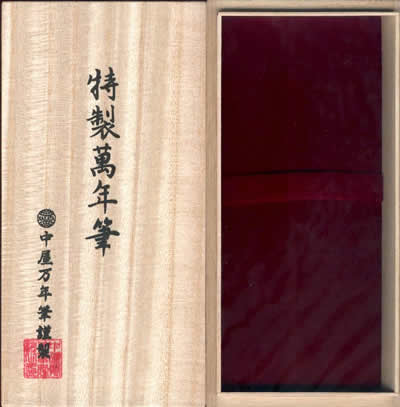
Nakaya box
Len: Would you have preferred to have just the pen (and
perhaps the pouch) if it would have made the purchase cheaper?
Fran: In the case of the Nakaya, I don’t think it would have lowered
the price all that much. I mean, this is really nice packaging, but its’
hardly expensive to produce. If I could have saved five, maybe twenty dollars,
no I’d still want the pouch and perhaps the wood box. I can’t imagine
the price would be that much lower. The packaging was restrained and tasteful.
Adam: No. Although I think the
packaging was probably more than $20 worth of material and craftsmanship, for
this particular pen I found the packaging to be a perfect complement to the pen.
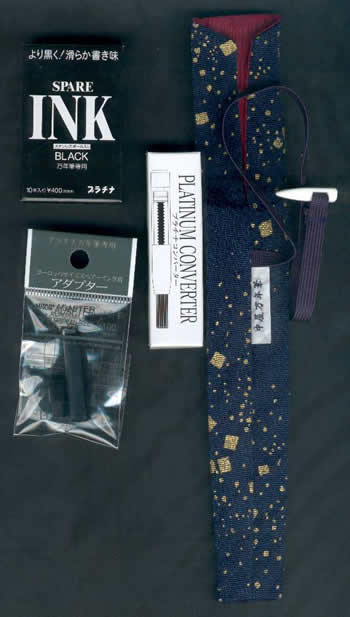
Package contents
Len: How does the flexibility of the soft nib compare to
vintage flex nibs or modern “flex” nibs like the Falcon?
Adam: It’s a semi-flex at best, akin to my Matador 811 alloy nib. To
get full flex (which you can see in my writing sample) requires significant pressure
and control, and I don’t do it often for fear of springing the nib. But
after two weeks of nearly constant use, the flex is still wonderful. I find the
Falcon soft and mushy but not flexible at all; the Nakaya is what I consider true
flex, and I prefer it to all but my Swans.
Fran: I sent back a Falcon. The cheap plastic had no appeal to me and the
nib was nothing like my now-gone vintage pens had. As I said before, it’s
not the flex that appeals to me, but the amount it has is very nice. Hardly vintage
flex but enough if you like a bit of variation. I’m not good with a flex
nib, but my picture shows how I write with it.
Len: How does this nib directly compare others of the same
type, such as your Stipula .09 stub or italic?
Fran: Mine is a standard (extra) fine nib with moderate flex, not an italic
or stub. No comparison would be fair here.
Adam: The stub is quite fine, so the line variation, while it’s there,
is quite subtle. I can only imagine how wonderful the stub nib is on a wider base.
It compares best to a fine stub Parker “51” that Richard Binder ground
for me—definite but subtle variation.
Len: Are you concerned taking your pen out into the world
with you -- to the office, etc?
Adam: Well, I treat it a little better than my other pens. But I’m not
concerned—it’s come to the office with me every day since I’ve
had it. Maybe I’m a little more neurotic about making sure it’s there
in my pocket or pen case or whatever, but it is first and foremost a writing instrument,
so I take it where I’m going to write with it.
Fran: Not at all. I always put my pens in cases or in my shirt pocket when
I carry them. This pen, like the Churchills, goes in pen cases. I refuse not to
use a pen I own and I refuse to keep them in the house. Those that I did “baby”
are now all sold off. Sure, I’ll be careful with it, but I want to own the
pen and not have it own me.
Len: Are you particularly careful with this pen as opposed
to others in your collection -- whether of equal, greater or lower value?
Fran: Well, I’ve only had it a couple of weeks, so yes I’m handling
it with a bit more care than my other pens, except for other ebonite pens. Yeah,
I tend to be a bit more conscious of being more delicate with my ebonite pens.
Probably don’t need to be, but I am.
Adam: This pen has a place of
honor among my pens. Along with my Sensa Meridien came a pen rest that’s
a soft cloth filled with flax seed. At the office, my Nakaya rests on this soft
and comfortable bed. For home, I bought a pair of chopstick rests at a local store
with the same coloring as my pen, which rests on them in a minimalist homage to
a real Japanese display.
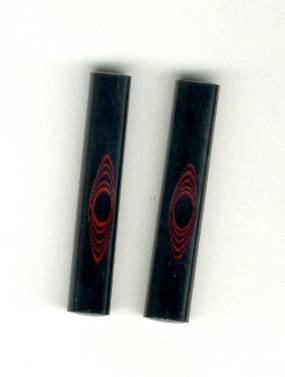
Pen "rests"
Len: How do you think the increased interest in Nakaya
will affect the company's mission to craft each piece by hand?
Adam: I am hopeful that the only effect it will have will be to lengthen the
lead time for them to craft each pen. I would hate to think that I contributed
in any way to a diminution of their quality. Frankly, I don’t think Nakata
san would let the quality deteriorate, so I expect to see longer waiting times
but no QC problems and no compromise on process or product.
Fran: Good question. I really don’t know. I’ll just ditto Adam
on this one.
Len: Given the dominance of Italian, German, English, some
old line Japanese and American pen manufacturers, what do you think lies in the
future for a smaller and highly specialized pen maker such as Nakaya?
Adam: I hope it's success. There has to be a fine line between being having
enough orders to craft everything by hand and remain in business and having too
much demand to maintain quality control. I'm hopeful Nakaya, advertising solely
through word-of-mouth, can maintain that line.
Fran: Again, it’s pure
speculation and I hate to speculate. Who knows? They are obviously making and
selling plenty of pens. They must already be quite successful. The Web site is
wonderful and must generate plenty of business. I’ve heard that the urushi
models are a real status symbol among young Japanese business types. If this is
true, then perhaps interest will fall off once it’s no longer the pen of
the hour. Who knows? My question is, who will be doing urushi lacquering on pens
ten, twenty, or fifty years from now?
The Nakaya Website
|